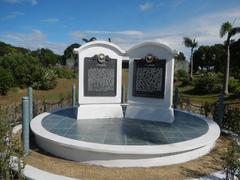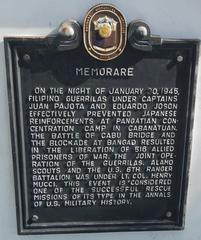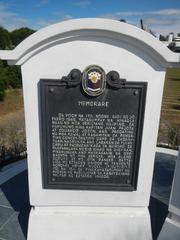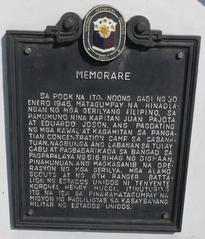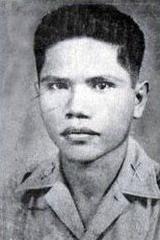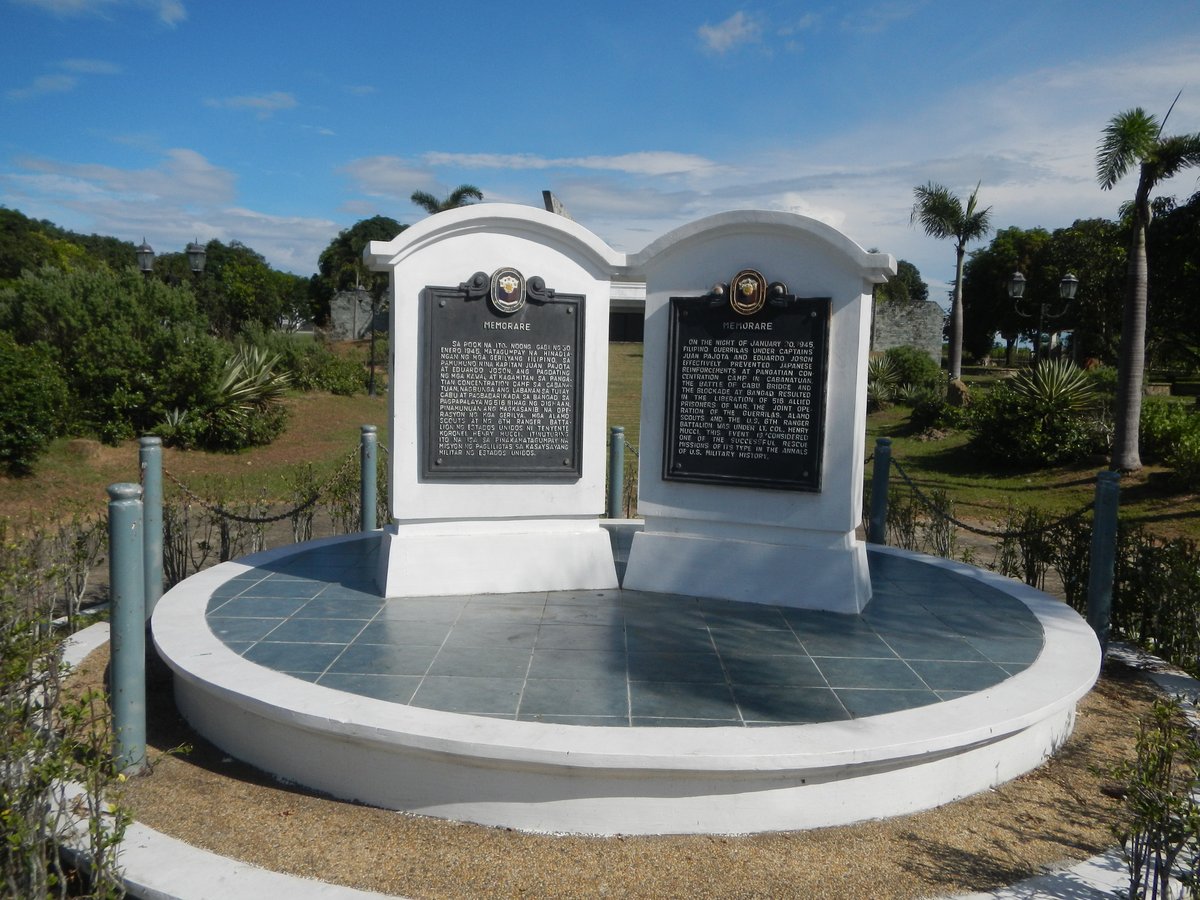
Memorare Historical Marker Visiting Hours, Tickets, and Guide: Cabanatuan, Philippines
Date: 14/06/2025
Introduction
The Memorare Historical Marker (Raid at Cabanatuan), located in Cabanatuan City, Nueva Ecija, stands as a solemn reminder of one of World War II’s most extraordinary rescue missions. This monument honors the January 30, 1945 raid, in which U.S. Army Rangers, Alamo Scouts, and Filipino guerrillas liberated over 500 Allied prisoners from the Japanese-run Camp Pangatian. Many POWs were survivors of the Bataan Death March, making the site a profound symbol of courage, sacrifice, and the enduring partnership between the United States and the Philippines. Today, the marker is an essential destination for history enthusiasts, educators, and travelers. This guide provides comprehensive details about the marker’s history, visiting hours, accessibility, nearby attractions, and practical tips for a meaningful visit (We Are The Mighty; Army.mil; Traveloka).
Table of Contents
- Historical Background of the Memorare Historical Marker
- Significance of the Memorare Historical Marker
- Features of the Memorial Complex
- Visitor Information: Hours, Tickets, and Accessibility
- Visitor Etiquette and Guided Tours
- Nearby Attractions in Cabanatuan
- Annual Commemorations and Events
- Frequently Asked Questions (FAQ)
- Plan Your Visit and Stay Connected
- Summary and Visit Tips
- References and Further Reading
Historical Background of the Memorare Historical Marker
The Memorare Historical Marker and Memorial Complex, also known as the Camp Pangatian War Memorial Shrine, is dedicated to the legendary Raid at Cabanatuan. Originally a military training ground, Pangatian Camp was converted into a POW camp by the Japanese after the 1942 fall of Bataan and Corregidor. Thousands of American and Filipino soldiers—many survivors of the Bataan Death March—were interned here, enduring harsh conditions (We Are The Mighty).
By late 1944, the Japanese “kill-all policy” threatened the lives of remaining POWs. On January 30, 1945, the 6th Ranger Battalion, Alamo Scouts, and over 200 Filipino guerrillas executed a daring rescue, liberating 511 Allied prisoners (Army.mil). This operation remains a symbol of international cooperation, strategy, and heroism.
Significance of the Memorare Historical Marker
Commemoration of Heroism and Sacrifice
The marker is a physical and symbolic tribute to the courage of American and Filipino forces, the suffering of POWs, and the critical role played by Filipino guerrillas. The raid’s success showcased intelligence, local knowledge, and the power of joint operations (We Are The Mighty).
Political, Cultural, and Educational Impact
This historic rescue boosted Allied morale and reinforced U.S.-Philippine ties. The site serves as both a venue for annual commemorations and an educational resource for visitors to learn about the realities of war, the value of freedom, and the importance of international solidarity (Army.mil; Audiala).
Features of the Memorial Complex
The Memorare Marker
At the heart of the complex is the Memorare Marker, inscribed with the names of those rescued and their liberators. The text recounts the events and honors those who perished in captivity. Benches and shaded areas provide space for reflection (Camella).
Memorial Wall and Plaques
Surrounding the main marker are plaques and memorial walls detailing camp history, the raid, and tributes to Filipino guerrillas. These features help contextualize the operation’s significance and the collaborative effort behind its success (We Are The Mighty).
Landscaped Grounds and Reflection Areas
Tranquil gardens and pathways encourage contemplation, remembrance, and respect. Visitors are guided through commemorative trees, markers, and the main shrine (Audiala).
Educational Displays
Educational panels include photographs, maps, and wartime narratives, allowing visitors to grasp the strategic and human dimensions of the raid (Camella).
Visitor Information: Hours, Tickets, and Accessibility
Visiting Hours
- Open Daily: 7:00 AM – 5:00 PM
- No Entrance Fee: Donations for maintenance are welcomed (Army.mil).
Accessibility
- Wheelchair Accessible: Paved pathways and ramps available.
- Restrooms and Parking: On-site facilities and parking for cars and buses.
- Directions: From Metro Manila, take NLEX and SCTEX to Cabanatuan City (3–4 hours by car or bus). Local tricycles and jeepneys are available for short distances (Camella).
Visitor Etiquette and Guided Tours
- Dress Modestly: The memorial is a place of remembrance.
- Respectful Behavior: Silence mobile devices; avoid loud conversations and disruptive actions.
- Photography: Allowed, but avoid flash during ceremonies or inside museum areas.
- Littering: Use designated bins.
Guided Tours: Local guides offer historical context and personal stories. Group tours and educational programs should be arranged in advance, especially during major anniversaries (Audiala).
Nearby Attractions in Cabanatuan
- Freedom Park: A tranquil city park for post-visit reflection (Trip.com).
- Museo de Nueva Ecija: Regional exhibits on culture and wartime history (Audiala).
- General Antonio Luna Marker: Adds further context to Cabanatuan’s historical significance.
- Fort Magsaysay Military Museum: Offers deeper insights into the Philippines’ armed forces.
- Local Cuisine: Sample batutay longganisa and Puno’s Ice Cream nearby (Camella).
Annual Commemorations and Events
Each January 30th, ceremonies are held featuring wreath-laying, speeches, and performances attended by veterans, officials, and descendants from both the Philippines and the United States. These events reinforce the raid’s enduring legacy and the spirit of international cooperation (Army.mil).
Frequently Asked Questions (FAQ)
Q: What are the visiting hours?
A: Daily, 7:00 AM–5:00 PM.
Q: Is there an entrance fee or tickets required?
A: No, the site is free for all visitors.
Q: How do I get there?
A: From Manila, take NLEX and SCTEX to Cabanatuan, then local transport to the site.
Q: Are guided tours available?
A: Yes, through local guides and by arrangement with historical societies.
Q: Is the site accessible for persons with disabilities?
A: Yes, though some pathways may be uneven; contact local coordinators for assistance.
Q: Is photography allowed?
A: Yes, but be respectful and avoid flash inside museums or during ceremonies.
Plan Your Visit and Stay Connected
For an optimal experience:
- Visit during cooler hours.
- Dress appropriately and bring sun protection.
- Consider joining a guided tour.
- Download the Audiala app for updates and digital resources (Audiala).
Stay connected with local tourism boards and official websites for event announcements and detailed travel information.
Summary and Visit Tips
The Memorare Historical Marker is a significant World War II site that honors the heroism and unity of Allied and Filipino forces. With free admission, accessible grounds, and a thoughtfully curated environment, it offers visitors a reflective and educational experience. Enhance your visit by exploring nearby heritage sites and engaging with local history. Annual commemorations and preservation efforts ensure the legacy of the Cabanatuan raid continues to inspire future generations (Army.mil; Audiala; We Are The Mighty).
References and Further Reading
- The Great Raid, We Are The Mighty, 2024
- US Philippines commemorate 80th anniversary of Cabanatuan raid, Army.mil, 2025
- Discover and Explore the Enchanting Tourist Destinations of Cabanatuan: A Journey into Beauty and Serenity, Traveloka, 2024
- Cabanatuan POW Camp: History, Visiting Hours, and Guide to Nueva Ecija’s Historic Site, Audiala, 2024
- Memorare Historical Marker and Camp Pangatian War Memorial, Camella, 2024
- Category: Memorare historical markers (Raid at Cabanatuan), Wikimedia Commons, 2025
Enhance your journey: Download the Audiala app for audio tours and historical insights. Follow local tourism boards and heritage organizations for event updates and travel tips.
